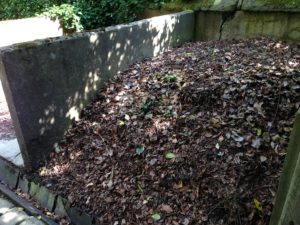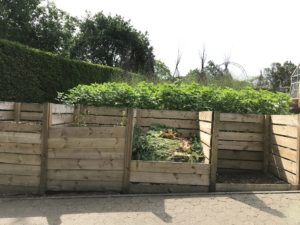Autumn frosts usually means lots of cleanup around the yard and garden. Why not turn that yard waste into treasure?
Composting is a naturally occurring process that breaks down organic materials into an excellent soil amendment that improves soil structure, as well as adds some nutrients. Composting will help you recycle your garden wastes, improve your soil and reduce disposal costs.
All organic materials will break down eventually, but gardeners can speed up the process with good management. The basic ingredients for successful composting include organic materials and microorganisms with the proper balance of carbon, nitrogen, water and oxygen.

Combine green and dry brown plant materials for composting
Photo credits: Rosie Lerner, Purdue Extension
Good candidates for composting include end-of-season garden plants, pulled weeds, grass clippings, tree leaves and plant trimmings. The smaller the particle size, the faster the organic materials will break down – chopped or shredded plants will compost more quickly. Some kitchen wastes, such as vegetable and fruit scraps, and coffee or tea grounds, can also be added. These materials should be buried in the center of the compost pile to avoid attracting insects, rodents and neighborhood pets.
Some organic materials are best left out of the compost pile because of possible health hazards or attractiveness to pests. Because of the danger of disease transmission, human and pet feces should not be composted. Meat scraps, bones and fats will likely attract unwanted visitors.
Backyard composters might do best to avoid materials heavily infested with weed seeds, insects and disease organisms. Although a properly managed compost pile should generate enough heat in the center to kill most of these pests, ensuring uniform heat can be difficult, particularly in a small compost pile.
Microorganisms, such as bacteria and fungi, are responsible for breaking down the organic materials in yard waste. Although commercially packaged compost starter is available, adding a little garden soil or finished compost will supply all the microbes you need for composting.
Microorganisms also require a proper environment to work efficiently. Nitrogen is needed by the microbes in order for them to break down and use the carbon found in organic materials. The ratio of carbon to nitrogen in the compost pile will affect the rate of decomposition. If the carbon content is too high, decomposition will be slow. If the nitrogen content is too high, ammonia gas can be given off, creating foul odors. The ideal ratio for composting can be achieved by combining fresh green with brown dry materials, such as fresh grass clippings with dry tree leaves. At this time of year when there is likely to be an abundance of dry materials, you can add a little dried livestock manure or packaged fertilizer if green materials are not available.
Water is also needed for efficient microbial action and uniform heating. Compost with optimum moisture content should resemble that of a moistened sponge that has the excess water squeezed out. Be prepared to water the compost if rainfall is lacking.
Oxygen is equally important for efficient decomposition and to prevent foul odors. Breakdown occurs more slowly when oxygen is lacking, and foul odors from fermentation will result.
The center of a properly managed compost pile will generate heat as the microorganisms break down the organic matter. A good-sized compost heap, approximately 4-5 feet in diameter and 4-5 feet deep, should reach 130-160 F in the center. Turn the pile with a pitchfork or shovel at least once or twice a month to keep the materials supplied with oxygen, and to bring outer contents to the center for heating. Small amounts of organic materials can be added to actively composting piles, but it’s best to start a new pile when compost becomes too tall to work by hand.
Compost can be ready to use in as soon as a month or as long as a year or more, depending on how well the pile is constructed and tended. Finished compost should look much like a uniform potting soil, with no indication of what materials originally went into the pile.
Compost can be used as a soil amendment in the garden to add some nutrients, but its primary advantage is that of improving soil structure. Adding compost increases water-holding capacity, aeration and nutrient exchange sites in the soil.
